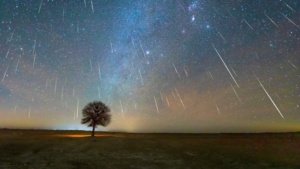A Guide to April’s Astronomical Wonder
Path of Totality courtesy of AccuWeather

From Issue 3, 2023-2024; science
Updated Mar 27, 2024
Solar eclipses have often been interpreted by civilizations across the globe as a harbinger or divine sign. Warring nations have put down their weapons in the ensuing darkness and understood the disappearance of the sun as a sign from the Gods in favor of peace (Turkey, 585 BC). But eclipses are calculable. Using 3,000+ year old records of solar eclipses that occurred in China, scientists were able to measure the daily deceleration of Earth’s rotation. Mayan civilizations kept meticulous astronomical records, allowing us to discover their accurate prediction of the solar eclipse of July, 1991.
On April 8th, you can have something in common with millions of people throughout history: you can put down whatever you’re doing and watch as the Moon overtakes the Sun. But what exactly will you be witnessing? During a total solar eclipse, the moon blocks out the Sun, leaving only its outer atmosphere: the corona. This is the ring of light visible around the dark circle in the sky.
Total eclipses are available to a smaller region than partial eclipses, which is when the Moon passes the Sun but misses totality by a sliver.
The “path of totality” of the solar eclipse highlights the portion of the country that will be able to see the total eclipse. A broader region shows the cities and towns beyond the borders of the “path of totality” that will be able to watch a partial eclipse. The path of totality is determined by the parts of the Moon’s shadow as it passes the Sun. The shadow has two parts: the penumbra and the umbra (which is within the penumbra). If the umbra falls on your town, you see a total eclipse. If you're in the penumbra, you see a partial eclipse.
The umbra spans a small fraction of the penumbra, so it's a good idea to look at the map in advance to know where to drive to watch the eclipse in its totality. Make sure to check what time to put on your glasses and look up, which depends on where you are and can end in just a few minutes.
So other planets with moons must experience total eclipses too, right? Solar eclipses are geometrical miracles: the only reason why we can experience them is because the Sun is 400 times bigger than the Moon and also 400 times farther away from us. This is why both seem to be the same size in our sky, and why moons on other planets can’t block out the Sun. So no, other planets don't have total solar eclipses. If things were simpler, we’d have eclipses more often: eclipses take place during new moons, which occur once a month. But, among other rotational dilemmas, the Moon’s orbit is tilted by about 5 degrees, so the Sun and Moon line up much more rarely. After April, the next total solar eclipse in the United States will be in 2044. So how wrong were past civilizations for thinking that eclipses are divine, really?



